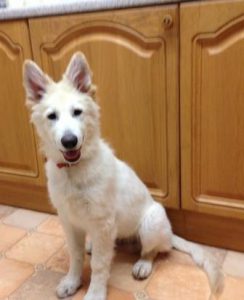They brought their two beautiful cream-coloured German Shepherd brothers home a couple of months ago at eight weeks old, believing they would be great company for one another thus making life easier and not realising it could actually be a lot more work.
They soon were given information that littermates could well become overly reliant upon one another, even to the extent of not bonding as fully with their humans as they might. One puppy can become overshadowed by the other and not reach his full potential. Puppy play can, as the pups mature, turn into full-blown fighting. This isn’t inevitable – I have been to siblings who are the best of friends – but it is possible that things could turn out not so well unless fairly special measures are taken. They called me in for professional guidance.
Already they have Samson and Buster, now sixteen weeks old, sleeping in separate crates. They walk them separately and they feed them separately. They will need individual training sessions. They have been having more one-on-one time with their humans than they have with each other which is perfect.
When I was there and for my benefit the two puppies were together more than they usually would be. We were in the conservatory watching them playing in the garden. It wasn’t long before play became unequal – even at four months old. Samson was becoming a bit too rough and Buster was getting scared. Their relative personalities are already very clear with Samson more nervous, more excitable and more bossy.
I was quite amazed actually at just how well-behaved the two dogs were for such young puppies and the hard work is paying off already. They are fully house trained and they don’t do chewing damage anywhere. There is a bit of jumping up from just Samson and they have already discovered that ‘get down’ doesn’t work. Their owners have, from the start, gradually weaned the two puppies into being left apart and all alone for reasonable periods of time.
There are a couple of ‘flags’ I feel they need to be aware of that could develop into problems. Prevention is a lot better than cure. Already Samson is barking in a scared fashion at people and other dogs when out, and Buster barks at dogs. Possibly, because they are currently held tight on short leads to try to stop them pulling, they feel trapped and uncomfortable.
The two dogs need as much socialising as possible. I know from personal experience that too many German Shepherds can be reactive and aggressive towards callers to their homes if the don’t regularly meet people from an early age. Plenty of people coming through the door would be good if they can find volunteers, and they should be associated with food or play.
With one dog at a time and the other shut away, we did very successful loose lead walking around the garden and the front of the house. We used a longer lead and using my technique the puppy simply walks around beside or following the person holding the lead. One of the puppies even had a pee when on lead, something they never do, and I suggest this is because he felt sufficiently comfortable and relaxed.
Samson likes to play tug of war with the lead, but reacting with reward when he stops rather than reacting with scolding or tension while he’s tugging will soon cure this.
The play between the two dogs needs careful monitoring, and terminating as soon as it ‘turns’.
With two soon-to-be large dogs, the owners need some sort of ‘remote control’, particularly in public, so the dogs will learn to respond instantly to their own names, to ‘come’ and to other cues like ‘sit’, ‘down’ and ‘stay’ requested gently and just the once. Over the next few weeks and months we will have a lot of fun!
My advice to them is to treat their puppies like one lives next door – for the forseeable future. They can meet frequently and be friends, but ‘live’ apart. Fortunately the couple has a good-sized house and the gentleman works from home, so logistically it’s possible. The couple have already researched and are well prepared to do whatever it takes.





